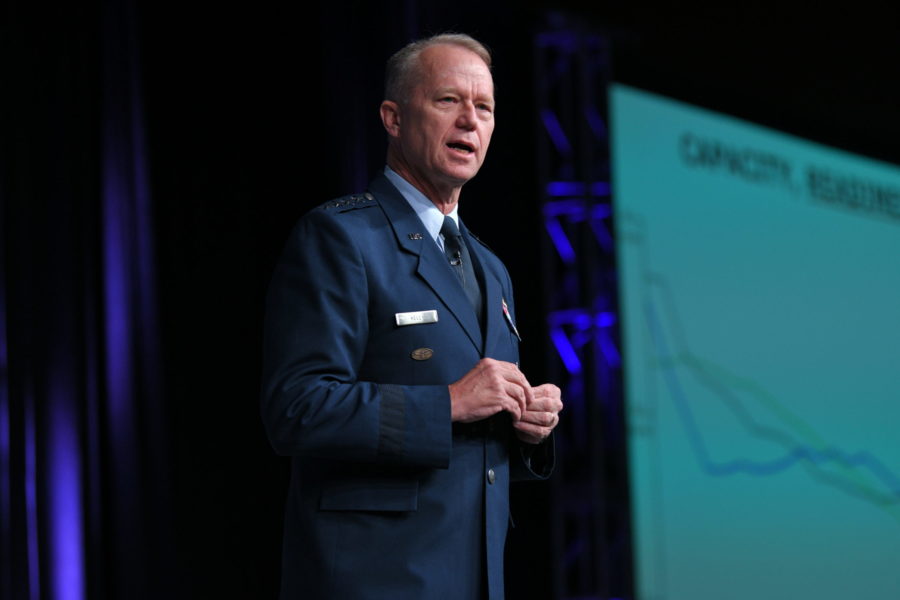The Air Force’s approach to developing Collaborative Combat Aircraft—uncrewed airplanes that will fly in loose formation with crewed airplanes to perform missions such as sensing and jamming—should be rapid but iterative, lest the service get the concept wrong and have to back up and start over, Air Combat Command head Gen. Mark D. Kelly said.
“Everyone is in agreement,” Kelly told reporters at AFA’s Air, Space & Cyber Conference, that CCAs are “something in our future,” and he expects early versions will be in the hands of Airmen to start experimenting with in less than two years.
Air Force Secretary Frank Kendall “is right” that the technology exists for prototype systems to be built, Kelly said, but the right approach will be to let pilots work with them and decide where to put the emphasis in further development.
“The captains will lead us through this,” he said. “That’s the path we’re going on: get the tools to the Airmen and get out of their way. Let them iterate and innovate.” He urged that the Air Force listen to those who will fight with the CCAs.
“Throw it into the mix … and learn,” he said. He said he’s sure that “if we try to foist” an end-item “on them and tell them how to do it, we’ll mess this up.”
The discussion now underway, he said, is “how are we going to get there? Are we going to swing for the fence and have these things almost operational in a short amount of time, or are we going to kind of get some singles and folks on base and try to iterate our way there?”
Kelly called himself a fan and an advocate of iteration, “because there’s so much we don’t know. And if we try to shoehorn our way into something … we may cue up an exquisite miss.” He also noted that exquisite capabilities usually end up being very expensive.
“And then if I build an exquisite CCA—exquisite means exquisite pricing—I could have a CCA that could punch into really, really highly-defended piece of airspace, I don’t have resilient comms, and that thing doesn’t know how to phone home … I don’t get it home.”
His advice to industry would be to make “clean sheet” CCA design “something you can iterate” with modular, interchangeable sensors, radar, jammers, etc.
“Unlock a nose, bolt on another nose,” he said. “Quickly take off the radars, put on the jammers,” so that the CCAs can rapidly adapt to a changing air battle.
“I would not lock us into…’it’s a sensor…a jammer…it can’t do anything else.’”
He acknowledges that many in the senior leadership want to go fast on CCAs; to rapidly put them in the field and start increasing the number of combat platforms for capacity, and also to impose cost on China by giving America’s pacing adversary more it must shoot at.
“I think we can iterate pretty fast,” Kelly said, but warned that “if we lock ourselves into” something of a certain size or capability, it could turn out to be “a race to failure … under the banner of ‘accelerate, change or lose.’”
If “we … find out we’re wrong, we have to go back to the start,” he said, and that would cost time and resources USAF doesn’t have to squander.
“But I agree with the Secretary: we need to start doing and iterating and test-driving this, and get ourselves away from some of the PowerPoint slides. … He’s right, that there’s enough out there that we can start iterating now.”
He also said the operational concepts and authorities have to develop in pace with the technology. Right now, he said, armed, uncrewed aircraft like the MQ-9 are limited to operations from just a few bases such as Creech Air Force Base, Nev., Tonopah Test Range, Nev., Holloman Air Force Base, N.M., and Tyndall Air Force Base, Fla.
He said he lacks the authority to land such an aircraft “anywhere I want in the U.S.,” which inhibits their ability to integrate with the force and be incorporated into large-force training.
“You can race down the track of autonomy, but if you don’t have the authority to go right with it,” the concept will falter, he said.
“So I’ve got to have autonomy, authority and resilient comms (communications)” to make the CCA concept work, he said.
Overall, it’s too early to be thinking about what squadrons will look like with a mix of crewed and uncrewed aircraft, but some are, Kelly added.
